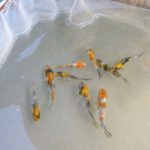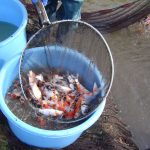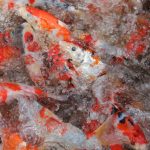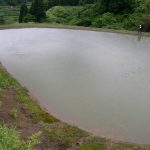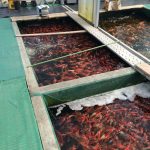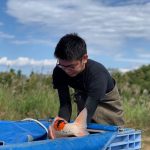What is the Autumn Harvest trip all about?
Why is the Autumn Harvests so popular when it comes to Koi?
In Japan most breeders bring all their Koi into their warm Koi facilities. Koi houses similar to many Koi dealer facilities. A number of ponds, all filtered and heated.
The Koi are fed and looked after over winter.
Koi in Japan are bred around the end of May – start of June. This is a very busy time for the breeders as they are up all hours of the day breeding many parent stocks. The large Koi breeders maybe up to 50 sets of parent Koi, the smaller breeders anything from 5 sets! You can work the numbers out yourself, but even if you take an average of 500,000 eggs per female, you can see how many Koi will hatch.
To make the point, which I have made many times before…
If a breeder’s parent Koi produce 5 Million eggs…with the very high culling of fry…they will be left with around 3000 saleable Koi.
When I say “They will be left with” let’s look at the process.
- In June the Koi spawn
- In June the fry Hatch
- In June the fry are put out into fry ponds.
- June till September they are grown – and culled every month.
- September – February they are kept in heated indoor ponds, kept at 23C and fed upwards of 6 times per day.
- February to April many are sold
- April to May the breeder selects which Koi to keep…
Which leads is onto The Harvests!
In May the Koi breeders of Japan now have the Koi that they bred a full 12 months before? Now these Koi are between 30-40cm! The Koi that the breeder has selected to keep, which will be less than 200 pieces go out to the main mudponds for a summer of growth. The breeders will check on them daily and make sure they are getting enough food. They have put these Koi in around 5/6 mudponds, space is key for their growth, so the stocking levels are very important.
So they have, May, June, July, August and September of uninterrupted eating and growing, no nets, no hassle…just very hot weather and plenty of room.
This is until buyers from every corner of the globe, arrive in mass to the mountains of Niigata and other areas of Japan. The start of October signals the start of the Harvest season.
This is where the breeders start bringing those 200 Koi in…remember them? They haven’t had a good look all summer! These Koi are the future of their business…have they developed? Are they male or female? Are they the best they have ever produced? Is there ‘THAT’ special Koi? They could have produced the best 2yr (Nisai) ever!!
Also, how are they all in general? Are they going to sell? Will dealers buy them? Do they have customers for them?
None Go-Sanke are pretty stable…so results can be guessed pretty much every season, so the breeder always knows, or has a good idea how they will be…but not with None Go-Sanke (Kohaku, Sanke and Showa)
These are different every single time, they are very to breed consistently. The breeders may have also tweaked the ratios from the year before, they may have put more or less in the mudpond…they may have used a different male…they may have used a brand-new female…So many factors which could change the final result. There are no 2 Koi the same…However if it’s a single colour Koi then the chances are you will get those single colours year in year out. With Kohaku, Sanke and Showa…there have never been 2 of these that are the same. So each year it’s all different! Have a think about it, this is another reason why Koi breeding is a very difficult art, and very risky!
The same time that all this happening. The breeders also have their new babies indoors, being fed…kept at 23C. They also have 3yr old Koi, 4 yr old koi and bigger in their facilities.
Now we split these Koi into 2 sections.
Koi which have not been sold
Koi which are being grown on for customers. (Azukari)
So not all breeders sell out every year (some do) so most breeders will always have a selection of different aged and sized Koi. Some hobbyists prefer to buy small Koi and grow them on, they want to go down the route of buying that special small Koi and hoping it will grow up to be a Grand Champion…some people buy smaller Koi because they cannot afford the bigger Koi. Some clients only buy 3yr old Koi, the risk is a little less than a 2yr old, and some Koi Keepers like to buy jumbo Koi! There is a lot of scope in Koi Keeping.
The second point, ‘Koi which are being grown on for clients’
It’s pretty much that. Clients will buy Koi and decide to leave them at the breeders if they are good enough for the breeder to keep, and if the growing cost is paid. On average, a Koi up to 2yrs old is around £350/£400…now this is an average costing…some breeders will charge more to use certain growing ponds.
This is a very popular thing that customers do. One of the 200 Koi I wrote about further up…let’s say a client buys one of those. Let’s say the Koi was 50cm in October, right after its been harvested. The client decides to leave the Koi in Japan… so that Koi (One of the original 200)
- Client buys Koi in October
- Koi is kept at breeders facility
- October – May. Fed sparingly and heated.
- May – Released into mudponds of Niigata to be grown
- May – October – Grown!
- October – Autumn Harvest time!!
So again…the Koi has come around again to be harvested, and now the Koi is 3yr old (Sansai)
And…The breeder is also harvesting another 200 Nisai he bred the year before… Confusing right?!
So, the Harvest time is when we see these Koi, at their age…harvested. The best they will look at that stage of life. We see them from the mud… We see the expectations…we see the success…we see the fails… We see how hard it is to produce these living works of art…
Brilliant.


